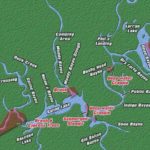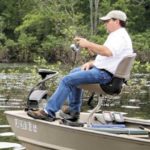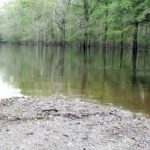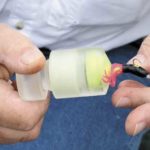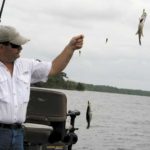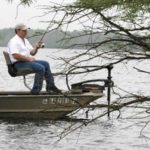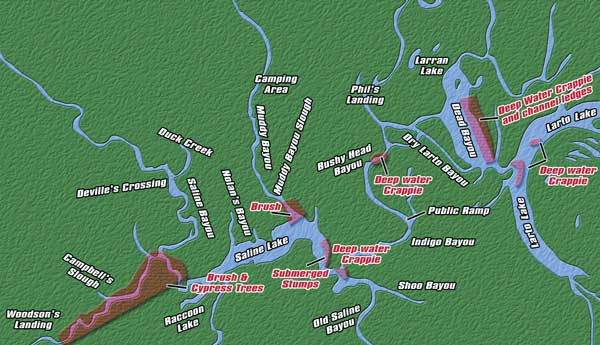
This year’s floods meant hard times for Saline-Larto crappie anglers, but now they get to reap the benefits.
Those who call Louisiana home are used to battling Mother Nature. Oppressive heat and humidity, hurricanes and the occasional ice storm are taken in stride as the price to pay for living in the Sportsman’s Paradise. Mississippi River floods, in particular, often ravage the state, but 2008 has been one for the record books. Not since 1973 have we experienced such a deep, prolonged inundation of the Big Muddy and its tributaries.
Many sportsmen lost their camps or watched helplessly as herds of deer headed for the hills, only to wonder if they would ever return to their leases.
But take heart! There is a silver lining on the horizon.
Floods are nature’s way of improving the environment. High water flushes debris out from the floodplains, carries rich nutrients to lakes and streams and rebuilds natural levees. Floods are also essential to Louisiana’s fisheries because they provide safe spawning areas deep in the woods, and allow fish to repopulate lakes that are normally landlocked.
The Saline-Larto complex in east-central Louisiana was one of the areas hardest hit by the recent high water. This region is basically a bowl that collects the spillover from Catahoula Lake and the Red and Black rivers. Much of it lies within the 60,000-acre Dewey Wills Wildlife Management Area. Within its confines, one has access to miles and miles of bayous and lakes that eventually connect to Larto Lake.
To experience high water crappie fishing on Saline-Larto, and to learn more about what the future might hold there, I met up with Randy Hulin at Woodson’s Landing outside Deville early one muggy morning. Hulin, who hails from Tioga, is a legend in crappie fishing circles, and has fished the complex for years.
Saline-Larto is one of the state’s most fertile waterways, particular for crappie, and Hulin has seen firsthand how floods affect it. He pointed out that every time there’s been a flood, there’s been a corresponding boom in crappie fishing.
“When the water is up,” Hulin said, “they spawn back in the woods where no one can get to them, and more of the fry survives. I think we’ll have an excellent fall and winter out here.
“It should be particularly good after this flood because it lasted longer than usual. This entire area is prone to flooding, but every so often it floods more than normal. The floods of 1973, 1997 and 2008 were especially bad. The one this year has lasted a long time because just when it began to fall out in the late spring, they got 11 inches of rain upstream around Shreveport. That kept the Red River up and prevented Saline-Larto from draining until this summer.”
Mike Wood, a biologist with the Louisiana Department of Wildlife and Fisheries, has extensive experience on Saline-Larto, and agrees with Hulin. When asked what effect the high water will have, he replied, “Very good. That is a backwater system. It thrives on backwater. Such spring floods cover new fertile ground and open up new spawning areas that are normally out of the water. The young fry have protection and also a lot of insects to feed on. You multiply that by acres and acres, and it has a great effect.”
Wood, however, cautions fishermen they probably won’t see the full benefits of the flood until a few years down the road.
“Crappie populations are cyclical in nature,” he said. “Floods actually drive the cycle, but they have to be well timed and last long enough to be beneficial.
“It normally takes about three years to see the benefits. There will be a great spawn this year, and next year there will be a lot of small crappie, and the year after that they will be a little bigger. In about three years is when you will really see a difference. Then people will start catching a lot of nice fish, but by that time they will have forgotten about the flood. Back in the 1980s, we had a number of floods on Saline-Larto, and the crappie fishing was great for several years.”
Hulin has certain tactics and baits to catch crappie when the high water comes. One thing he does not use, however, is shiners.
“I’m a jig man,” he said. “If they don’t want my jig, I’ll let them be. Every time there’s been high water, a pumpkinseed jig has been good. This kind of high water brings in a lot of grass shrimp that the crappie eat, and that’s a good jig to imitate the shrimp.”
Moving down Big Creek from the landing, we first stopped at an area that was indistinguishable from all the other open water. But Hulin knew there was structure a few feet beneath the surface.
“When the water comes up, it covers the shoreline brush, lilly pads and grass, and you then have a lot of submerged structure to fish,” he said.
But you have to know where to look. Those not familiar with the complex would have motored past this particular spot unaware of the flooded brush.
To work the unseen structure, Hulin uses a light spinning rig to toss out a 1/8-ounce jig suspended about 3 feet beneath a cork.
“I like to use a 1/8-ounce jighead,” he said, “because it makes the cork stand up. When the fish are hitting light, the cork will just lay over on its side. Also, with a 1/8-ounce jig head, I can get it out there farther.”
Hulin cast out as far as he could, and worked the jig back to the boat with short jerks.
“This is how we learned to fish this place,” he said. “You can cover a lot of water, and find where they are and pattern them.”
After 20 minutes or so without any luck, Hulin decided to look for better water conditions. He has found the crappie often bite well when the water starts to drain out of the complex.
“Whenever there is a current when the water starts to fall, you can do good drifting with the current using a jigging pole,” he said. “The fish face upstream to feed on what’s being washed out, and you can bring your jig right to them. But make sure you always move with the current. If you work upstream against it, you approach the fish from the rear and sometimes spook them.”
We motored all the way to the weir on the Diversion Canal, but Hulin could not find exactly what he was looking for. One troubling thing he had noticed when we first launched was the color of the water. It was a darkish brown, almost the shade of tea.
Wood says this is common, and can be one of the downsides to backwater floods.
“In the short term, fishing might actually suffer a bit when the water starts going out because it will have a high tannic content from all the leaves and debris in the swamp,” he said. “It’s really a funky mess, real dark in color and often low in oxygen content. You might even see some isolated fish kills. But later in the summer when it settles out and clears up, the fishing should really improve.”
From the color of the water, it was obvious Hulin and I had arrived when it was still stained with the tannic contamination. As a result, the crappie were not cooperating very well in the bayous.
After striking out around some more submerged brush and green cypress trees, Hulin decided to move to one of his favorite spots — Larto Lake. He was cautiously optimistic we would do better there.
“Larto is where the big fish are; that’s where they come from,” he said.
Fishing this open water requires different tactics than those used around brush and trees. On Larto, there is less chance of snagging on stumps and limbs, so Hulin uses a jigging pole in each hand with four different-colored jigs on each pole.
The rig is designed to cover the maximum amount of vertical water column so he can locate the crappie quickly. A No. 10 barrel swivel is used to attach a 5-foot section of 6- to 8-pound line to his main 10-pound line. Four colored jigheads spaced a foot apart are tied onto the lighter line.
Hulin explained why he uses the lighter line for his jigs.
“When you’re fishing relatively clear water, the heavier line sometimes will spook the fish,” he said. “Using a light line for your jigs can make a big difference in getting them to bite.”
Even in open water, however, the jigs sometimes snag on the bottom or a stump, and the lighter line breaks. It can take considerable time retying four jigs, so Hulin simply makes up a number of rigs before he goes out, and wraps them on a handy board he keeps in the boat. When he loses a rig, he can quickly tie on an entirely new line and be back to fishing in no time.
With the four-jig rig and two poles, Hulin can offer the crappie eight different-colored jigs at eight different depths. It’s then simply a matter of paying attention to which color and depth produce the most fish, and start changing out jigs.
“When I start out, I have four different jigs on each pole, but by the end of the day when I’ve figured them out, I have four of the same jig on each pole.”
We stopped just inside Larto Lake near Youngblood’s Landing, where the water is 13 feet deep.
“In the deep open water, I like to fish just off the bottom,” Hulin said.
He then dropped his jigs, and one pole immediately bent down.
“There’s one,” he grunted.
Hulin had found the fish, and we now started pulling up a few. On one occasion, he even wrestled in two crappie on one pole.
I soon found Hulin had a secret weapon that definitely seemed to give him an edge. Some years ago, he invented a simple but ingenious device called the Bait Pump (thebaitpump.com). After filling the small container with crappie nibbles, the nozzle is inserted into a tube jig, and the nibbles can be pumped directly into the bait. It is a much more effective way to use crappie nibbles than simply attaching them to the hook.
Hulin explained the advantages the Bait Pump gives him.
“First, by using different-colored nibbles you can change the color of a jig if it’s somewhat transparent,” he said. “It also plumps up the jig to make it bigger, and it helps the jig stay on the jig head better. Most of all, it makes the crappie take the jig more aggressively. A lot of times crappie will just bite down and quickly spit out a jig, but when it’s full of nibbles, the fish will hold it long enough for you to set the hook.”
In short time, we caught about a dozen crappie in the deeper water of Larto Lake. This type of open water fishing is what Saline-Larto is famous for, and even those unfamiliar with the area can join in the fun.
“Just look for the boats,” advised Hulin. “When you see several in the same area, they’ve located the fish.”
Crappie fishermen in the complex are used to sharing an area, so don’t be shy about easing in to join them. But be a sportsman. Don’t run up on a bunch of boats and then kill your motor. Show some courtesy by stopping a couple of hundred yards away and using your trolling motor to slip in quietly.
On this particular day, there was a slight chop on the lake that required the constant use of the trolling motor. It wasn’t too bad, but the wind can sometimes be brutal on Larto. Hulin has learned, however, not to call it a day just because it starts to get rough.
“Many people make the mistake of quitting when the wind picks up,” he said. “When it gets bad, I weigh my jigs down with a split shot of lead, and use a drift sock to slow the boat. Last winter, we had a gathering of crappie fishermen here, and everyone went in when the wind started blowing. I stayed out here with my drift sock, and caught a bunch of ’em.”
By mid-afternoon, we were worn out from the heat and humidity, and decided to call it a day. Back at the landing, I talked with Leon and Dot Woodson, owners of Woodson’s Landing. It is the oldest landing in the Saline-Larto complex — Woodson’s father, a commercial fisherman, opened it in the 1920s. It is also the only landing that remains open during very high water. The Woodsons, in fact, maintain a high-water ramp just for that purpose. They also rent mobile homes, cabins and RV spaces.
Woodson said the 2008 flood was the worst the complex had seen since 1997. But, like everyone else who is familiar with Saline-Larto, he is confident the flood will only improve the fishing.
“This high water is good for the fish for a couple of reasons,” he said. “For one thing, it brings in a lot of fish from the rivers that flow through here. Fish can come into the complex from the Red, Black and Little rivers. We get a lot of large crappie from the Red in particular.
“Plus, you have a much better spawn during high water. The fish can get back in the woods away from fishermen and scatter out. This is really going to help the next few years.”
One thing that has reinforced the benefits of this year’s flood is the slow fall of the water.
“If it falls too fast, a lot of the fish will go out with the water,” Woodson said. “But with this slow fall, most of the fish will stay here.”
Woodson had some advice for newcomers to the area.
“Fish four-feet deep or so around the cypress trees because that’s where the grass shrimp will be,” he said. “They eat a lot of shrimp. You can cut open their stomachs, and they will be filled with little shrimp tentacles and even bits of cypress bark, where they were getting the shrimp off the tree. The grass beds are also full of shrimp, and are good places to look for crappie, bream and bass.”
Once the water has fallen completely out of the complex, Woodson says fishermen should look for crappie around the ledges.
“Those crappie will look for cooler water as it warms up, and the cooler water will be deep,” he said. “They’ll fluctuate in depth as the temperature changes, so you have to try different depths until you find them.”
Woodson added that the high water will help all fish species, not just the crappie.
“It is really going to help the bass fishing on Saline-Larto,” he said. “Not long ago, they stocked Florida bass in the Red River between the locks, and a lot of those bass have come into the complex with this high water.
“I talked to a biologist, and he said the Florida bass don’t like a lot of current. They should grow faster in the complex because they don’t have the same current as in the Red, and there’s a lot more baitfish to feed on here.”
He noted that the bass fishing had already picked up considerably.
“We’ve been having people coming and launching late in the afternoon and limiting out on bass before dark fishing around the grass,” he said.
It was obvious the bream were also turning on. While talking with Woodson, a man came into the store and said he and his daughter caught 40 big bluegill not far from the landing while fishing around the grass.
“All I did was bait crickets,” he chuckled.
A few weeks later, the water had fallen completely out of Saline-Larto, and I decided to try the crappie one more time with my friend Tommy Brister. This time we launched at the Saline Bayou public ramp inside the management area. One thing I noticed immediately was that the water had cleared up considerably.
We tried a variety of places and depths, and found everyone was dead-on in predicting good post-flood fishing. Using Hulin’s multi-jig set-up on jigging poles, we probed a submerged stump bed on lower Saline Lake and the deep water in Larto, and eased parallel down the bank line along the channel drop-offs.
Everywhere we stopped we caught some crappie, along with the occasional bluegill and catfish. The size of the fish varied considerably, but we did notice the deeper water of Larto Lake produced the largest crappie.
In a little over half a day of hot summertime fishing, Brister and I landed 40 crappie. It was a good sign of things to come on Saline-Larto.
